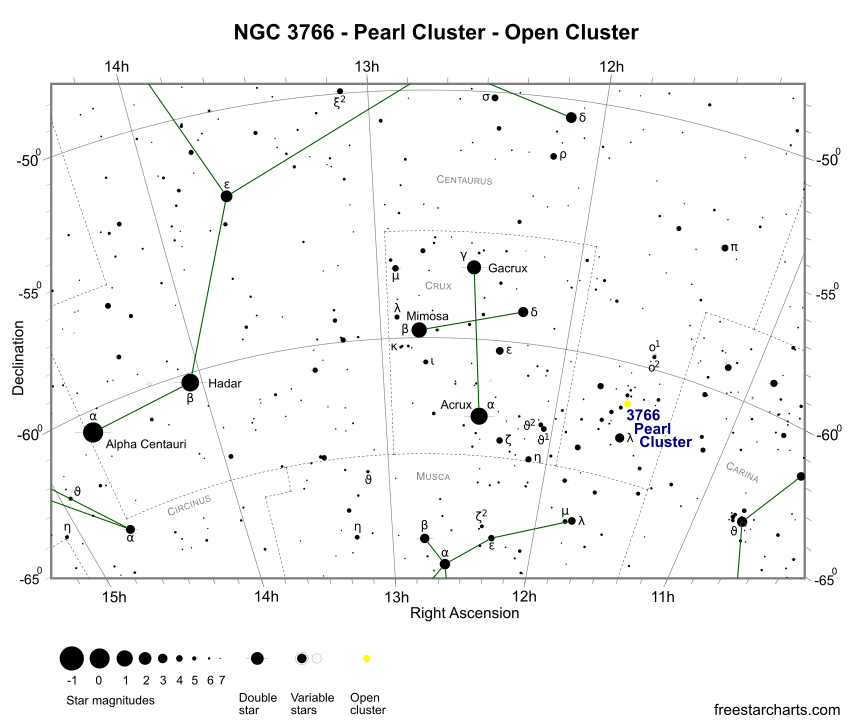NGC 3766, also known as the Pearl Cluster, is a superb open cluster in Centaurus. At magnitude +5.3, it's faintly visible to the naked eye but challenging to spot against the numerous stars of the background Milky Way. The cluster was born in the Carina molecular cloud, a vast star-forming region that lies at approximately between 6,500 and 10,000 light-years distant. It includes the barely-stable star eta Carinae (η Car), which one-day will explode as a spectacular supernova.
NGC 3766 is a nice binocular target, a wonderful sight through telescopes and one of the jewels of the southern sky. With a declination of 61S, it's best seen from southern latitudes during the months of March, April and May. From many southern towns and cities, the cluster is circumpolar and therefore never sets. However, from northern locations above 29N it never rises above the horizon.
Nicholas Louis de Lacaille discovered NGC 3766 on March 5, 1752.


Finder Chart for NGC 3766 - pdf format (credit:- freestarcharts)
The Pearl Cluster is located in the southwestern corner of Centaurus, 7 degrees west and slightly north of Acrux (α Cru - mag. +0.8). Positioned 1.5 degrees south of NGC 3766 is lambda Cen (λ mag. +3.1) and surrounding open cluster and associated emission nebula, IC 2944.
Binoculars show a compact cluster, spanning 12 arc minutes, with a number of stars resolvable. An 80mm (3.1-inch) refractor at 100x magnification reveals a stunning object with dozens of stars visible. Most members are white in colour, but the look is enhanced by a couple of nice 7th magnitude red stars. One red star is positioned left of the cluster centre, the other to the right. The appearance of NGC 3766 has been compared to the Wild Duck Cluster (M11) in Scutum and M37 in Auriga.
Through a medium 200mm (8-inch) scope, NGC 3766 is a stunning sight that appears bright, colourful and fully resolvable. At the extreme northern edge of the cluster lies eclipsing binary BF Cen, which varies between magnitudes +8.5 and +9.4 every 3.7 days. In total, 137 stars have been identified, but it's not clear how many of these are actually members.
NGC 3677 is 5,500 light-years distant and has a spatial diameter of 20 light-years. It's estimated to be 20 million years old.
NGC 3766 Data Table
| NGC | 3766 |
|---|---|
| Name | Pearl Cluster |
| Caldwell | 97 |
| Object Type | Open Cluster |
| Constellation | Centaurus |
| Distance (light-years) | 5,500 |
| Apparent Mag. | +5.3 |
| RA (J2000) | 11h 36m 14s |
| DEC (J2000) | -61d 36m 36s |
| Apparent Size (arc mins) | 12 |
| Radius (light-years) | 10 |
| Age (years) | 20 Million |
| Number of Stars | 137 |
| Other Names | Collinder 248, Melotte 107 |